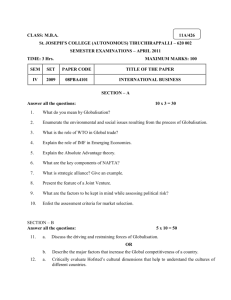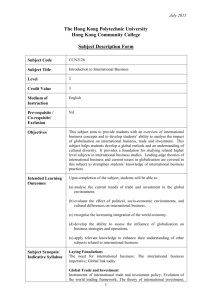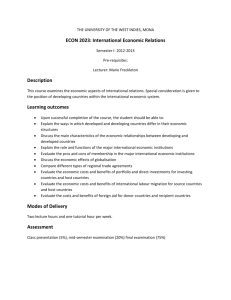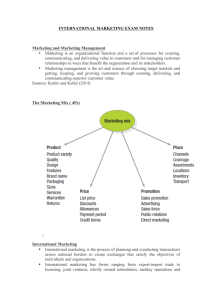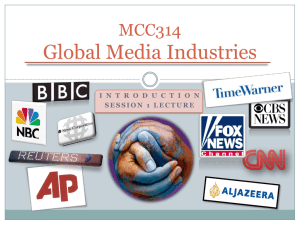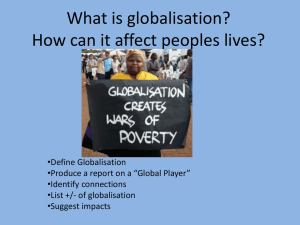What are the economic benefits of globalisation?
advertisement
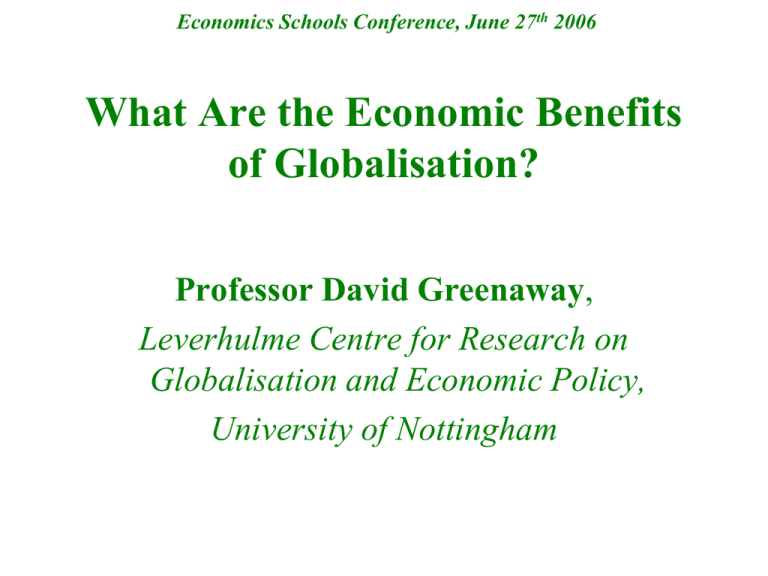
Economics Schools Conference, June 27th 2006 What Are the Economic Benefits of Globalisation? Professor David Greenaway, Leverhulme Centre for Research on Globalisation and Economic Policy, University of Nottingham Some Questions • • • • What is Globalisation? What Drives Globalisation? What are the Benefits of Globalisation? Why is Globalisation Controversial? What is Globalisation? Economic Globalisation - a process whereby national markets become more integrated and more interdependent 19 70 19 71 19 72 19 73 19 74 19 75 19 76 19 77 19 78 19 79 19 80 19 81 19 82 19 83 19 84 19 85 19 86 19 87 19 88 19 89 19 90 19 91 19 92 19 93 19 94 19 95 19 96 19 97 19 98 19 99 20 00 20 01 20 02 Growth of World Trade and Output 1000.0 100.0 Merchandise Exports Manufactured exports Merchandise production Manufactured output What’s in a Shirt? This morning I went out and bought a shirt…..the shirt I bought represents a triumph of international cooperation. The cotton was grown in India from seeds developed in the United States; the artificial fibre in the thread comes from Portugal and the material in the dyes from at least six other countries; the collar linings come from Brazil, and the machinery for the weaving, cutting and sewing from Germany; the shirt itself was made up in Malaysia……..(and was bought in the UK). From Paul Seabright The Company of Strangers: A Natural History of Economic Life. Princeton University Press (2004) What Drives Globalisation? • Key Indicators of Globalisation – International trade – Cross border investment and international outsourcing – Cross border migration – Financial market integration Recent Trends in Trade • Value of Trade (2004) Merchandise $8,907 billion Services $2,125 billion • Growth of Merchandise Trade 1950-73 7.0% per annum 1974-90 4.0% per annum 1990-04 7.6% per annum • Growth of Services Trade 1990-00 6.5% per annum 2001-04 10.8% per annum Recent Trends in Foreign Direct Investment ($billion) 1982 1990 2004 FDI Inflows 59 209 648 FDI Inward Stock 802 1,954 8,902 Foreign Affiliate Sales 2,737 5,675 18,677 Foreign Affiliate Assets 2,091 5,899 36,008 Global GDP 11,758 22,610 40,671 20th / 21st CENTURY DRIVERS OF GLOBALISATION • • • • • Falling man-made barriers Falling natural barriers Increased capital mobility Increasing labour mobility Technological development Falling Man-Made Barriers AVERAGE TARIFF RATES 30 25 20 15 10 5 0 France Germany Italy 1950 Pre-Uruguay Round UK Post-Uruguay Round EU US Falling Natural Barriers 120 100 80 60 40 20 0 1920 1930 1940 Ocean freight 1950 1969 Air Transatlantic phone 1970 Satellite 1980 1990 What are the Economic Benefits of Globalisation? • Specialisation and exchange – more efficient use of scarce resources – lower prices for consumers • Consumer choice – wider range of goods and services What are the Economic Benefits of Globalisation? • Stimulus to economic growth – access to capital and labour – access to new technology • Poverty alleviation – employment creation – economic growth Growth of Real Income Per Person (Per cent per year) 1960s 1970s 1980s 1990s Rise in Trade/GDP (per cent) Globalisers 1.4 2.9 3.5 5.0 Non-globalisers 2.4 3.3 0.8 1.1 104 -18 Source: Dollar and Kraay (2000) Real Income per Person (1990 dollars) Africa China India Latin America UK USA 1870 444 530 533 698 1913 585 552 673 1,511 1950 852 439 619 2,554 1998 1,368 3,117 1,746 5,795 3,191 2,445 4,921 5,301 6,907 9,561 18,714 27,331 Source: Maddison (2001) 90% 1,400 80% 1,300 70% 1,200 60% 1,100 50% 1,000 40% 900 30% 800 20% 700 10% 600 0% Number Rate SHARE OF WORLD POPULATION 1,500 18 20 18 50 18 70 18 90 19 10 19 29 19 50 19 60 19 70 19 80 19 92 NUMBER Extreme Poverty in the World Why is Globalisation Controversial? DISTRIBUTIONAL ISSUES • Uneven shares of gains from trade > intra-national (capital vs. labour; skilled and unskilled labour) > international (developed and developing countries) • Uneven shares of gains from FDI > intra-national (capital vs.labour; skilled and unskilled labour) > international (host and source countries) Why is Globalisation Controversial? INTERNATIONAL RULES • ‘One set of rules for them and one set for us’: > Coverage (e.g. movement of capital vs. movement of people) > Application (e.g. intellectual property vs. antidumping) • Ideologically Driven International Organisations > ‘Washington Concensus’ > Marginalisation of Developing Countries Why is Globalisation Controversial? ADJUSTMENT FRICTIONS • We do not live in a world of perfect competition • Some individuals and groups suffer short-run and maybe long-run losses • Winners are widespread, losers are concentrated • Adjustment policies do not always compensate Jobs in the United States have been perceived as moving abroad ……. to low wage Japan in the 1950s and 1960s, to low wage Mexico in the 1990’s and most recently to low wage China. We can usually identify in advance which jobs will be displaced by foreign or domestic competition. But in economies at the forefront of technology, most new jobs are the consequence of innovation, which by its nature is not easily predictable. We can thus be confident that new jobs will replace old ones as they always have, but not without a high degree of pain for those caught in the job-losing segment of America’s massive job-turnover process. Alan Greenspan, Chair of US Federal Reserve Board Conclusions • Globalisation is not a new phenomenon • The current wave of globalisation is the most intense since the nineteenth century • The pace of change is accelerating • There are long run gains from globalisation • But, there may also be short run costs for some • And some adjustment and distributional aspects of the process may need to be managed For resources on globalisation: www.gep.org.uk
